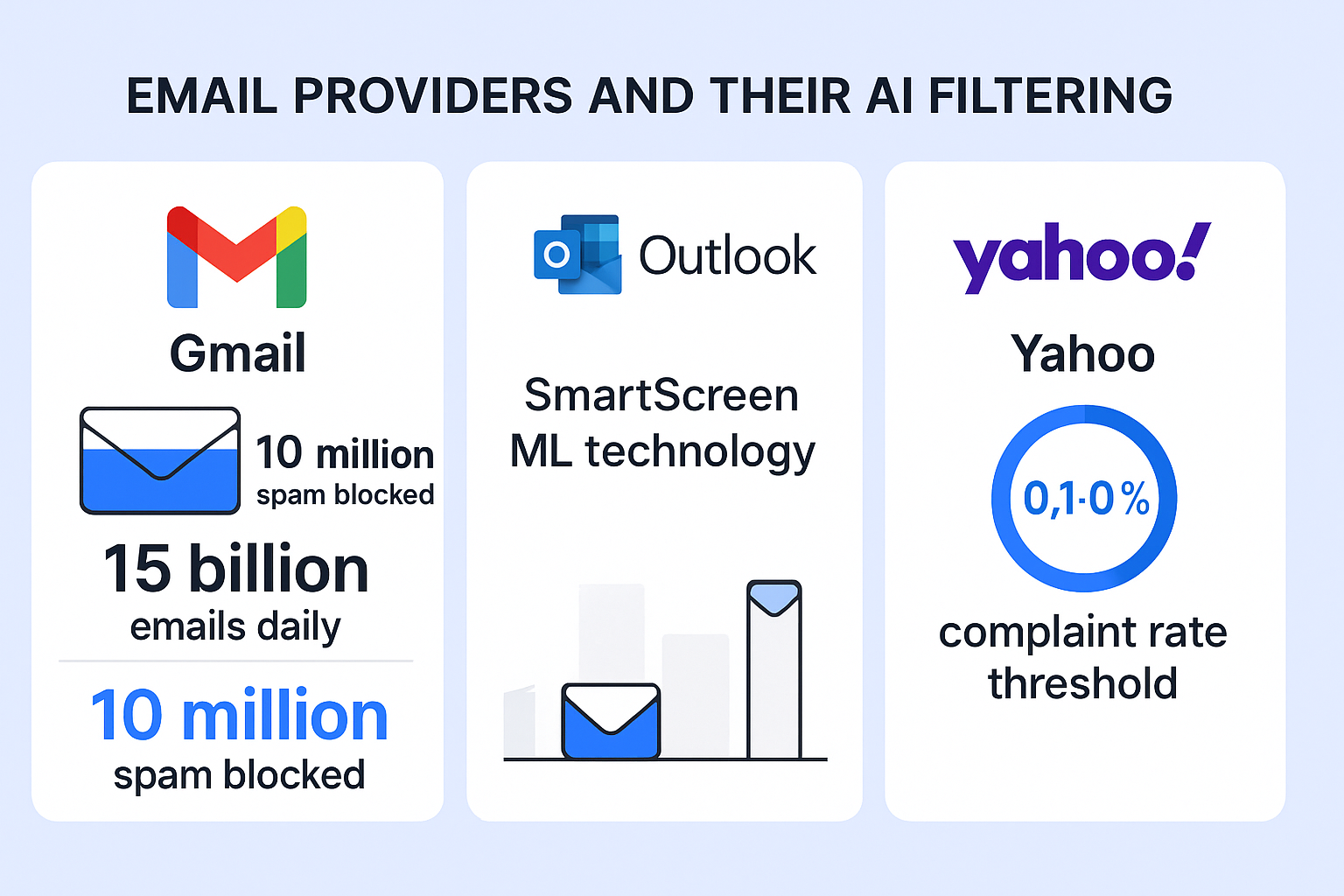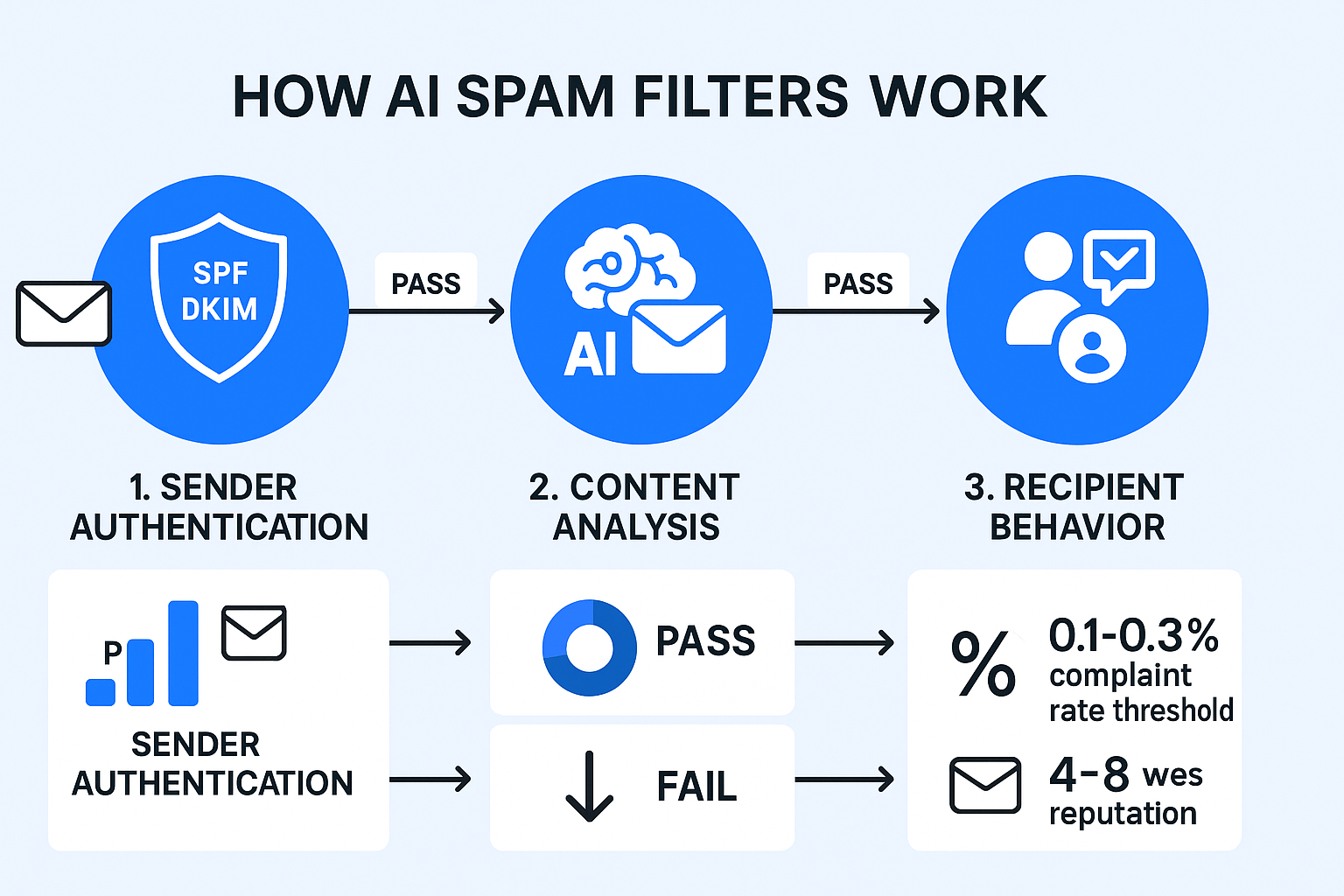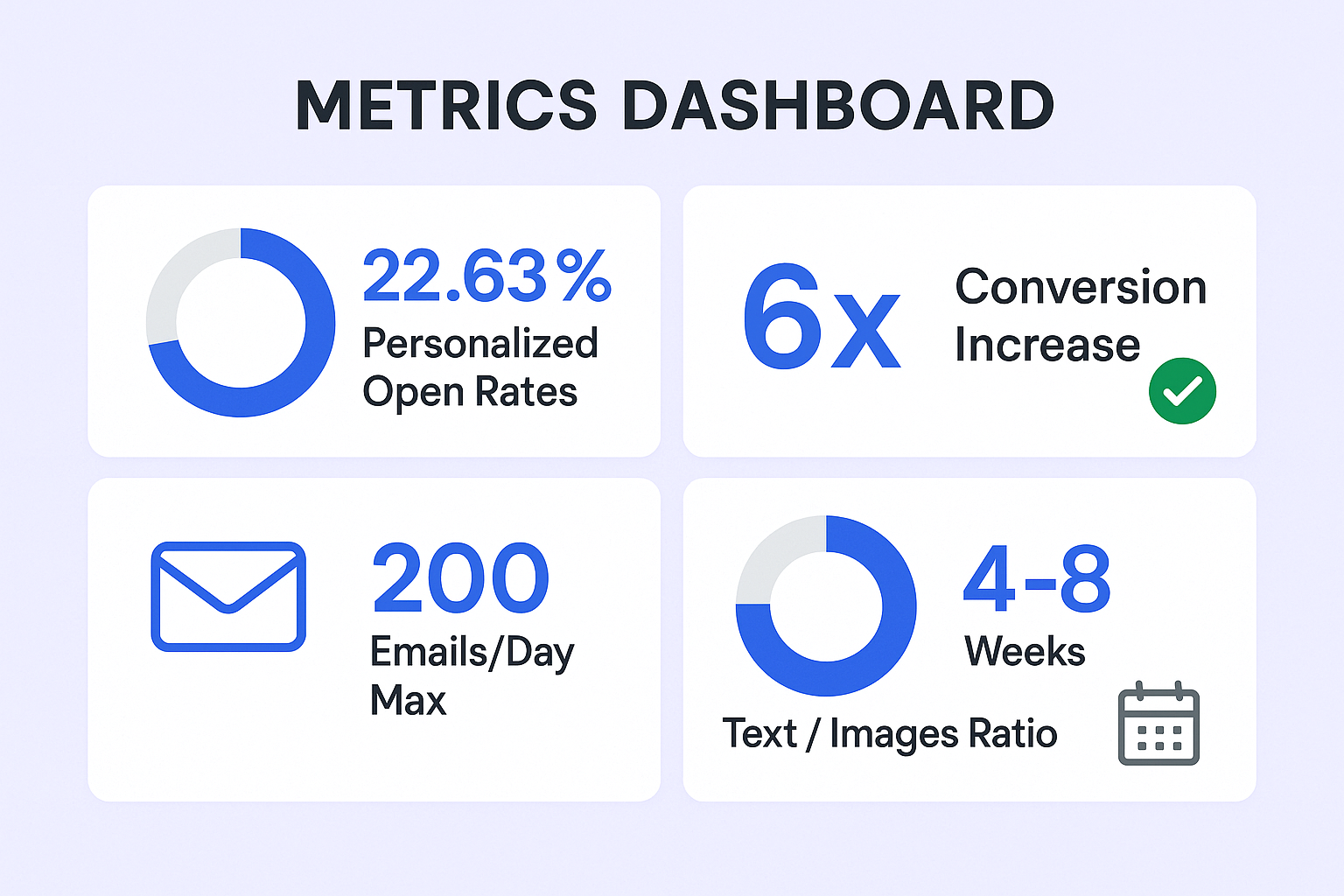- blog
- Cold Emailing
- Avoid Spam Filters with AI: Your Complete 2025 Guide

Table of Contents
Your perfectly crafted email just vanished into the spam folder. Again.
You’re not alone. 16.9% of legitimate emails never reach their intended inbox, with AI-powered spam filters becoming the invisible gatekeepers of modern email communication. But here’s the thing – once you understand how these AI systems work, you can craft emails that consistently bypass them.
The email landscape has transformed dramatically. Over 50% of spam emails are now written by AI, creating an arms race between spam creators and the filters designed to stop them. This means your legitimate outreach is competing against increasingly sophisticated, AI-generated content for inbox placement.
The stakes couldn’t be higher. Email marketing still delivers an impressive $42 ROI for every $1 spent, making deliverability crucial for your success. Let’s dive into how you can master this new reality.
Which Providers Use AI Filters?
Every major email provider now relies heavily on artificial intelligence AI to protect their users’ inboxes. Here’s how the big three implement their defenses:
Gmail processes over 15 billion emails daily, using advanced machine learning algorithms that analyze sender reputation, content patterns, and user behavior. Gmail’s AI filters block over 10 million unsafe emails every single day, learning from each interaction to become more sophisticated.
Outlook employs SmartScreen technology, combining machine learning with user feedback to assign “spam confidence levels” to incoming messages. This system determines whether emails reach the inbox, get quarantined, or face immediate deletion.
Yahoo Mail uses enhanced machine learning to scan for blacklisted IPs, poor domain reputation, and user complaints. Their filters have become increasingly strict, requiring spam complaint rates to stay below 0.1%-0.3% to maintain good deliverability.
The reality is stark: there’s no escaping AI spam filters. Every major provider uses them, and they’re getting smarter by the day.
⚡ Beyond AI Spam Filter Complexity
LinkedIn outbound engine eliminates deliverability concerns with strategic targeting frameworks
How AI Spam Filters Work
Unlike traditional rule-based spam filters that relied on keyword blacklists, modern AI systems use machine learning to continuously adapt and learn. These filters analyze hundreds of factors simultaneously, from sender reputation to content patterns to recipient behavior.
The old method was simple: if an email contained words like “FREE” or “GUARANTEE,” it got flagged. Spammers quickly learned to circumvent this by writing “FR33” or “GUARANT33.”
Today’s AI filters are far more sophisticated. They understand context, analyze writing patterns, and even detect when content appears artificially generated. This creates a complex challenge – your emails must appear genuinely human while avoiding patterns that trigger automated filtering.
The Three Pillars of Modern Spam Filtering
- Sender Authentication & Reputation AI systems first verify you’re who you claim to be through SPF, DKIM, and DMARC protocols. Then they analyze your sending history, bounce rates, and recipient engagement to assign a reputation score.
- Content Analysis Advanced algorithms examine your email’s text, images, links, and formatting. They look for spam trigger words, suspicious patterns, and signs of AI-generated content.
- Recipient Behavior Tracking Filters monitor how recipients interact with your emails. High open rates, clicks, and replies boost your reputation, while deletions without reading or spam reports damage it severely.
ML Model Processing: Where the AI Magic Happens
The heart of modern spam filtering lies in machine learning algorithms. Each uses different approaches to identify and block unwanted emails:
Naive Bayes
This probabilistic classifier operates on the principle that certain words and phrases appear more frequently in spam emails than legitimate ones. Naive Bayes filters can achieve up to 98% accuracy by analyzing the statistical likelihood that an email is spam based on its word content.
However, these filters have vulnerabilities. They can be fooled by “Bayesian poisoning” (deliberately including legitimate words to confuse the algorithm) and struggle with image-based spam where text is embedded in pictures.
Support Vector Machines (SVM)
SVMs excel at pattern recognition by finding the optimal “boundary” that separates legitimate emails from spam in a multi-dimensional space. They’re widely regarded as one of the most effective methods for email classification due to their strong generalization capabilities.
These systems work particularly well with high-dimensional text data, making them ideal for analyzing complex email content and identifying subtle spam patterns that other methods might miss.
Random Forests
This ensemble method combines multiple decision trees to make classification decisions. Random Forest classifiers achieve impressive 95.87% accuracy rates in spam detection by reducing the risk of overfitting that single decision trees face.
The strength of Random Forests lies in their ability to handle large datasets with many variables while maintaining high accuracy across different types of spam attacks.
Deep Learning Neural Networks
Representing the cutting edge of spam filtering, neural networks can automatically extract optimal features from raw email data. Advanced models using RNNs, LSTMs, and attention mechanisms achieve over 99% accuracy on various datasets.
These systems continuously update their understanding as spammers evolve their tactics, making them highly effective against new and emerging spam techniques. However, they require massive computational resources and extensive training data.
16.9% Lost Emails vs 100% Delivery
Complete LinkedIn strategy delivers messages directly without AI filtering or authentication issues
Choosing an Algorithm
Email providers don’t rely on a single algorithm. Instead, they use ensemble methods that combine multiple approaches:
- Gmail uses a hybrid system combining various machine learning models
- Outlook blends traditional rules with advanced machine learning
- Yahoo employs multiple algorithms working in parallel for maximum accuracy
This multi-layered approach makes it nearly impossible for spammers to game the system, but it also means legitimate senders must excel across all evaluation criteria.
Impact of AI Spam Filters on Email Deliverability
The rise of AI spam filtering has created both challenges and opportunities for email marketers:
The Challenges
Increased False Positives: As filters become more sensitive, legitimate emails sometimes get caught. 6.4% of emails now disappear entirely during delivery, never reaching either inbox or spam folder.
Higher Standards: The bar for email deliverability continues rising. What worked last year may not work today as AI models continuously evolve and adapt.
Personalization Requirements: Generic, template-based emails are increasingly flagged. Personalized emails are 6 times more likely to drive conversions because they appear more human and relevant.
The Opportunities
Better Targeting: AI forces marketers to focus on quality over quantity, leading to more effective campaigns and higher ROI.
Improved Engagement: By demanding higher-quality content, AI filters inadvertently push marketers to create more valuable, engaging emails.
Competitive Advantage: Understanding AI filtering gives you a significant edge over competitors who still rely on outdated tactics.
Key Statistics That Matter
- 22.63% – Average open rate for personalized emails vs. generic ones
- 320% more revenue generated by automated, well-targeted email campaigns
- 200 emails per day – Recommended maximum for AI-assisted sending to avoid triggering filters
- 60% text, 40% images – Optimal ratio to avoid image-heavy spam flags
Future-Proof Professional Outreach
LinkedIn campaigns provide reliable prospect engagement while AI makes email increasingly difficult
Proven Strategies to Beat AI Spam Filters
Success in the AI-filtered email landscape requires a multi-faceted approach:
Master the Technical Foundation
Authenticate Your Domain: Properly configure SPF, DKIM, and DMARC records. These aren’t optional – they’re mandatory for serious email marketing.
Warm Up New Domains: Gradually increase sending volume over time. AI filters are suspicious of sudden volume spikes from new or previously inactive domains.
Monitor Your Reputation: Use tools like Google Postmaster or specialized deliverability platforms to track how providers view your sending domain.
Craft Human-Centered Content
Hyper-Personalize Beyond Names: Include industry-specific details, recent company news, or mutual connections. AI filters recognize and reward genuine personalization.
Maintain Natural Language: Avoid overly promotional language, excessive punctuation, and ALL CAPS text that screams “automated marketing.”
Balance Content Types: Maintain the optimal text-to-image ratio and limit links to essential, high-value resources.
Optimize Sending Behavior
Segment Ruthlessly: 51% of marketers consider segmentation their most effective strategy because it drives higher engagement rates that AI filters reward.
Focus on Engagement: Track clicks and replies, not just opens. Apple’s Mail Privacy Protection has made open rates less reliable, but engagement signals remain crucial.
Test Continuously: A/B test everything from subject lines to send times. Marketers who consistently test generate significantly higher ROI.
Frequently Asked Questions About AI Spam Filters
Q: Can I completely avoid AI spam filters?
Q: Do AI filters learn from individual user behavior?
Q: How long does it take to build good sender reputation?
Q: Are there specific words I should never use?
Q: How do AI filters detect AI-generated content?
Conclusion
AI spam filters aren’t going anywhere – they’re only getting smarter. The email landscape has permanently shifted from quantity-based to quality-focused outreach. Success now depends on understanding these AI systems and working with them, not against them.
The key principles are clear: authenticate your domain properly, create genuinely personalized content, maintain consistent sending behavior, and prioritize recipient engagement above all else. Email marketing still delivers exceptional ROI, but only for those who adapt to this new reality.
The choice is yours: continue fighting an impossible battle against increasingly sophisticated AI, or evolve your strategy to work within this new ecosystem. Those who adapt will find their emails consistently reaching engaged recipients, while those who don’t will watch their messages disappear into digital oblivion.
Your prospects are waiting in their inboxes. Make sure your emails actually reach them.

Skip AI Spam Filter Battle
LinkedIn outbound bypasses email filtering completely with direct professional messaging platform
